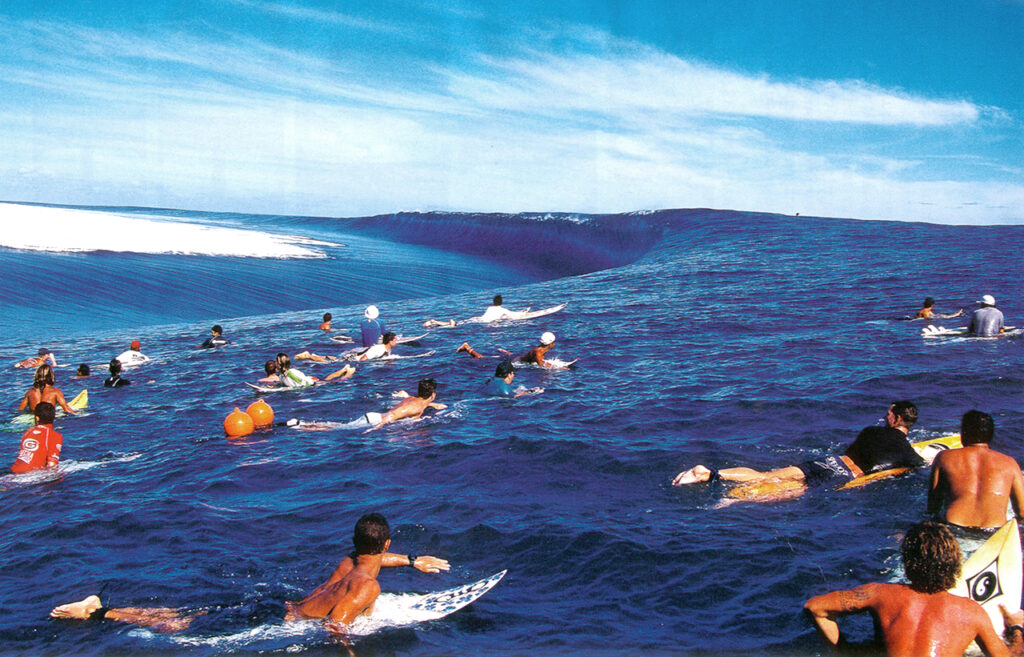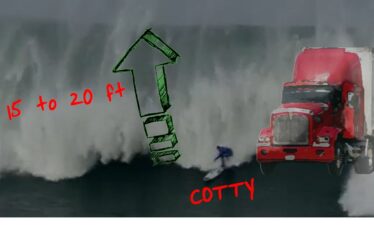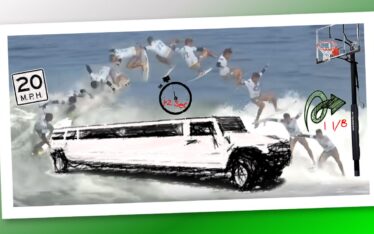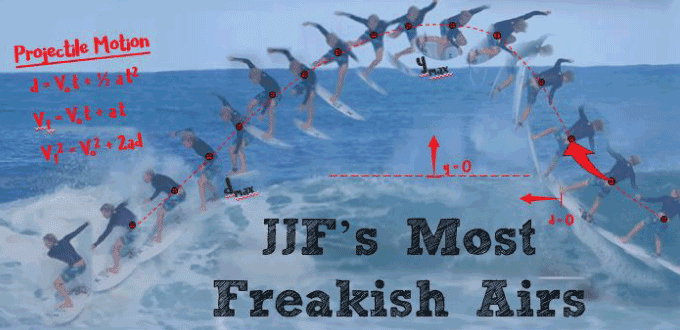
Teahupo’o looks more like a gaping hole in the sea than a rideable wave. Its mechanics have been thoroughly studied and well explained. But when I watch it, all I can think about is the carnage and to be honest, it makes me uncomfortable. I look at the energy this wave carries and wonder what these surfers and the WSL water patrol are subjecting themselves to? The sheer thickness of the wave combined with the lurching, overhead lip is what really stands out. It’s pretty impossible to calculate the volume of water that makes up this wave, but now that the Tahiti Pro is on, there’s no reason we can’t talk about some theoreticals.
Let’s consider another day at Teahupo’o with about 10-foot faces. The face, or the rideable front of the wave, is often about two to three times taller than the back of the wave. So, in these conditions the curling top of the wave, or the lip, can be well over a meter (3.3 feet) thick, and twice as long. By approximating the shape of that lip, we can calculate its cross-sectional area. Multiply that by a length and we have a volume of water. A two-meter length of the lip, which is covered by these surfers in about a quarter of a second or the duration of a short sneeze, has a volume in excess of four cubic meters. The mass of a cubic meter of water is 1,000 kilograms or about 2,200 pounds. In other words, that section of the lip weighs around 9,000 pounds. That’s about double the weight of that Toyota Tacoma that just drove by. Remember, we’re not talking about the entire rolling wave, just a small chunk of the lip!

Ryan Callinan, where nobody dreams of being. Photo: Cestari/WSL
The energy of that falling lip is just incomprehensible. If we use the above dimensions, it’s nearly 40,000 joules of energy dropping from the sky. That’s about how much energy that Tacoma has when it’s moving about 15 mph. Not real fast, but again, we’re comparing a small section of a wave to a moving truck! I know that doesn’t seem fast compared to your everyday driving, but a car striking a person at that speed will throw them a good 10 to 15 feet forward. Not trivial by any means. Realistically though, only a portion of that energy is actually transferred to the surfer when it crashes down. With that said, it only takes about 60 joules of energy transferred to the head to cause a concussion. That’s a pretty good smack, but in conditions like this, it’s easy to imagine. It was really great to see a few surfers out there rocking helmets, including Owen Wright and Sebastian Zietz.
As scary as the wave and surface of Teahupo’o are, the subsurface is even more imposing. Waves are created by incoming water encountering shallower depths. In other words, there is nowhere else for the water to go but up, so it does. In Tahiti, this change in depth is incredibly drastic. My understanding is that it goes from several hundred feet just outside to less than ten feet in areas where they are actually surfing (even landing on dry reef sometimes at low tide when the wave dissipates). Yes, that massive sprawling wave is rooted in incredibly shallow water and when they are riding it, there are less than a couple meters of water underneath them. The bottom is obviously coral reef. That means it doesn’t move when you hit it. There is really no limit to the injuries that can result. Superficial cuts are a gift, with shredded rashies and deeper lacerations much more commonplace.
It’s daunting to think that traumatic brain injuries are associated with head velocities as low as four meters-per-second, or about nine mph. In other words, if the surfer’s body and head are moving in excess of that speed when contact is made with the reef, a brain injury is pretty likely. Severe neck injuries can occur at even lesser speeds if the head is pocketed and the remainder of the body continues forward. There are too many variables to accurately estimate how a surfer’s body will be slowed down when it contacts the water and how fast it will be traveling when it experiences any contact with the bottom. But it’s worth considering that the jet-skis are going faster than 30 mph when they tow surfers into this wave.
My goal isn’t to dissuade anyone’s interest in Teahupo’o. I’m just trying to help us all appreciate the sheer audacity of what we are able to witness, oftentimes, from the comforts of our couch. I applaud each and every participant of events like the Tahiti Pro as it takes an entire village, literally, to make sure everyone stays safe out there. The more we know, the better suited we are to try and do just that.



About The Author
Michael Sinnott
My background is in Biomechanics and Engineering. I work in Forensics, so I'm the guy that gets called to figure out what happened and why. I own BioLogic Forensics LLC, and offer forensic services out of Oahu, Hawaii. I love what I do and am passionate about people. Work related or not, I'm always investigating something. Whether I'm working or surfing or diving or fishing, I'm proud to share my stories. After all, I'm just a kid from suburban Detroit living out his dreams in Hawaii!